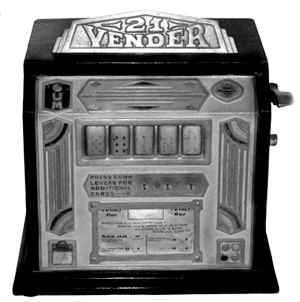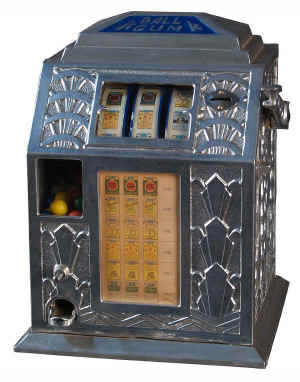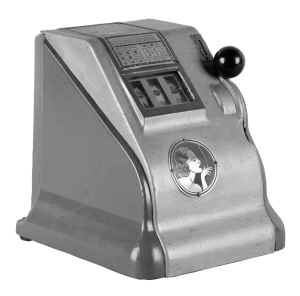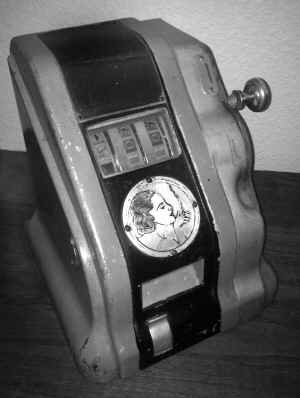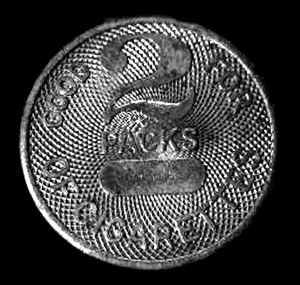|
A Game of Chance
Trade simulators became popular in American saloons during the 1880s. Eventually, cigar, confectionery and general store owners saw their potential for generating business and began using them. Produced in a wide range of designs, these little machines originated around the same time as slot machines. A player inserted a coin and pulled a lever. If he or she got a winning combination, they won prizes of cigars, cigarettes, candy and other goods. Some had beer reel strips for play and payout tokens worth a mug of beer or five mugs or more, depending on the winning token amount or what the payout card read. If a game didn’t payout in tokens, players could exchange their payout card towards purchasing products at the owner’s establishment. When certain states prohibited gambling, business owners could use these machines generally without fear of prosecution.
Inserting a penny in the coin slot and pushing down the brown-knobbed handle would cause the machine to fully function, then allow the handle to pneumatically return to the raised position. If the player didn’t insert a coin, the handle could still be pushed down, but the machine wouldn’t function. The coin would drop onto the floor of the machine and the reels would spin briskly and then lock into position. If three-of-a-kind emblems appeared in the windows, a token would be dispensed from the lower right side of the machine. The shop owner could collect coins from the floor of the machine by removing the back door and tipping the machine to the rear while taking care to insure that the reel mechanism didn’t slide out.
The benefit to the machine's owner was that customers would usually have to insert more coins than the merchandise's retail value, thus netting the owner additional profit. For example, where a customer could purchase a pack of cigarettes outright for 15 cents, he might pay 20 cents or more before winning a pack from a trade stimulator machine—doubling the profit for the owner when the wholesale price was 10 cents per pack. Groetchen also produced the Mercury trade stimulator, made of cast aluminum. A plaque reading "MERCURY, INSERT 1¢ TO SPIN REELS, TEST YOUR SKILL, LINE UP THREE OF A KIND, FOR AMUSEMENT ONLY" appeared on the top of the unit. The mechanism used brass-clad tokens, each marked "GOOD FOR 1 PACK OF CIGARETTES." As with the Liberty model, its reel strips contained emblems of cigarette packs. Groetchen’s "Ball Gum" machine released a gum ball if the player didn’t win on the reels.
To further hide that a machine gave winners cigarettes, which weren’t allowed to be given as game prizes in some states, some tokens had different numbers of stars rather than saying "2 packs" or "5 packs." Groetchen also made a trade stimulator machine called the Ginger, which appeared on the market in June, 1937, and took the star tokens. As with the mints tokens, it was probably possible to exchange tokens for cash, at least at some establishments. Groetchen also manufactured the "Columbia" in a variety of models from 1936 through 1948, with four years off for World War II from 1942 to 1945. Though a bit smaller in size than most of its other trade stimulators, the Columbia had a clever feature. The coins going in dropped into a rotary carousel escalator. When a player got a winner, the last coins played in got paid out, so someone trying to slug the machine would only win their slugs back. That little feature made it a money maker. It was also an inexpensive machine, selling for around $50 new while other larger machines sold for around $100 at the time.
Take the Groetchen "Tavern" model, for example. Several years ago, only a few of these appeared in collections. Today, there are a large number of them, many of which are being made up from other models. Groetchen made several different variations of this machine, using the same case style. Four of them have removable cast nameplates on the top casting—"The Bartender," "Ball Gum," and "The Fortune Teller." The others have the name as part of the top casting. To create the phony Taverns, unscrupulous people remove the original plate or mill the cast-in name off the others to make a smooth area for a new recast Tavern nameplate. Also, Groetchen only produced its Tavern machine with the front casting having a three-vertical-bar design to the right of the award card area. Some have shown up with the flowery broach design to the right, and most of that design had the award card frame as part of the front casting and wasn’t the removable four-screw frame style. Then they replaced the original reel strips and award cards with fake ones. The reason for all this subterfuge is money since the popularity of the Tavern model with collections has caused a demand, which, in turn, has driven prices for it up.
This same Buckley machine is also being transformed into two other bogus models. Fakers remove the original fruit or cigarette strips and reward card, and then install a set of Tavern beer strips, along with a made-up award card, with either the Bartender or Bar Boy name placed on it. Buckley never made machines like these. And to show how gullible some beginning collectors are, several have sold on eBay. One eBay buyer made the seller take the machine back.
As an avid collector of a variety of antiques and collectibles for the last 20 years, Bob Brooke knows what he’s writing about. Besides writing about antiques, Brooke has also sold at flea markets and worked in an antique shop, so he knows the business side too. His articles have appeared in many antiques and consumer publications, including British Heritage, Antique Week, Southeastern Antiquing and Collecting Magazine, OldandSold.com, and many others. To read more of his work, visit his main website at www.bobbrooke.com or his specialty antiques site at www.theantiquesalmanac.com PHOTO CAPTIONS: A few trade stimulators featured card games on the reels. Ballgum trade stimulators gave a gumball to those who didn’t win on the reels. Later, fakes of these machines came on the market. Groetchen’s most popular trade stimulator was the Liberty. It was a good size and simple in design. The Mercury was a smaller unit which took up less counter space. It gave out brass tokens to the winners. Groetchen’s Tavern trade stimulator wasn’t that popular when it was made, but collectors have put it in high demand, resulting in fakes flooding the market. Most trade stimulators gave players a token if they won on the reels. The player could then exchange the token for cigarettes or other items sold at the business. The earlier trade stimulators had reels featuring seven different brands of cigarettes. The player had to line up three of a kind to win. |
